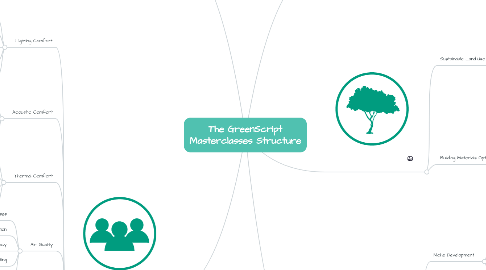
1. Discover Better Project Opportunities
1.1. Conditioners Evaluation
1.1.1. Integrative Process (Part 1)
1.1.2. Owner's Needs & Options
1.1.3. Connectivity Assessment
1.2. Climate Evaluation
1.2.1. Understanding The Building Envelope
1.2.2. Climatology 101
1.2.3. Climate Data & Bioclimatic Strategies Analysis
1.2.4. Increasing Your Repertoire of Sustainable Strategies
1.2.5. Sketchup Basics (Bonus)
1.2.6. Early Design Optimization (With Energyplus)
1.3. Definition of Sustainable Goals
1.3.1. Integrative Process (Part 2)
1.3.2. Boost Clients Health And Well-Being
1.3.3. Raise Social And Environmental Benefits
1.3.4. Increase Your Architecture & Design Value
1.3.5. Earning Potential & Payback Analysis
2. Boost Clients Health & Well-being
2.1. Lighting Comfort
2.1.1. Artificial Lighting Assessment
2.1.2. Artificial Lighting Simmulations (With Dialux)
2.1.3. Natural Lighting Assessment
2.1.4. Natural Lighting Metrics for Simmulations
2.1.5. Natural Lighting Simmulations (With Lightstanza and Energyplus)
2.2. Acoustic Comfort
2.2.1. Air Conditioning Background Noise Assessment
2.2.2. External Noise Assessment
2.2.3. Reverberation Assessment
2.2.4. Sound Reinforcement and Masking Assessment
2.3. Thermal Comfort
2.3.1. Thermal Comfort Fundamentals
2.3.2. Thermal Comfort Modeling Analysis
2.3.3. Thermal Comfort Specifications Optimization
2.3.4. Thermal Confort Control Implementation
2.4. Air Quality
2.4.1. Filtering Processes
2.4.2. Cross Contamination Prevention
2.4.3. Flush-out Before Occupancy
2.4.4. Air Testing
2.4.5. Smoking Control
2.5. Develop Human-nature Relationships
2.5.1. Biophilic Design Main Concepts
2.5.2. Environmental Elements
2.5.3. Natural Forms
2.5.4. Natural Patterns and Processes
2.5.5. Light and Space
2.5.6. Relations of Place
2.5.7. Evolved Human-nature Relationships
2.6. Increase Social Relationships
2.6.1. Create Secure Places for Privacy
2.6.2. Create Places for Social Interaction
2.6.3. Create Vibrant Mixed Use Places
2.6.4. Create Inclusive Places
2.6.5. Provide High Quality Pedestrian Spaces
2.6.6. Create Quality Views
3. Increase Your Architecture & Design Value
3.1. Building Energy Optimization
3.1.1. Passive Strategies Applications
3.1.2. Project Design Optimization (With Energyplus)
3.1.3. Green Roof Design
3.1.4. Brise Soleil Calculations
3.1.5. In-Context Renewable Energy Choices
3.1.6. Renewable Energy Pre-sizing
3.1.7. HVAC Optimization
3.1.8. Comissioning Evaluation
3.1.9. Demand and Response Evaluation
3.1.10. Monitoring Processes
3.2. Water Use Reduction
3.2.1. Indoor Fixtures Optimization
3.2.2. External Systems Optimization
3.2.3. Landscape Specifications
3.2.4. Monitoring Processes
4. Raise Social And Environmental Benefits
4.1. Sustainable Land-Use
4.1.1. Building Location Optimization
4.1.2. Building Intuit Optimization
4.1.3. Rainwater Management
4.1.4. Development Footprint Reduction
4.1.5. Heat Island Effect Reduction
4.2. Building Materials Optimization
4.2.1. Project Area Optimization
4.2.2. Feasibility Study of Construction Processes
4.2.3. Materials Reuse
4.2.4. Strengthening the Local Economy
4.2.5. Priority Materials
4.2.6. Material Transparency
4.2.7. Waste Management
4.2.8. Elimination of Harmful Materials
5. Communicate Better Your Differentials
5.1. Niche Development
5.1.1. Finding Your Differentials
5.1.2. Client Transformation Structure
5.1.3. Main Services Structure
5.1.4. Social Network Disclosure
5.2. Positioning Development
5.2.1. Company Positioning Structure
5.2.2. Educational Process Structure
5.2.3. Educational Scripts Structure
5.2.4. Social Content Structure
5.2.5. GreenScript Achievements Communication
5.2.6. GreenScript Propostal Model
5.3. Growth Development
5.3.1. Organizing Your Scale
5.3.2. Creating Your Audience
5.3.3. Creating a Scaled Communication
5.3.4. Increasing The Value of Your Work
5.3.5. Dealing With Sustainable Objections
5.3.6. Dealing With Growth Obstacles
